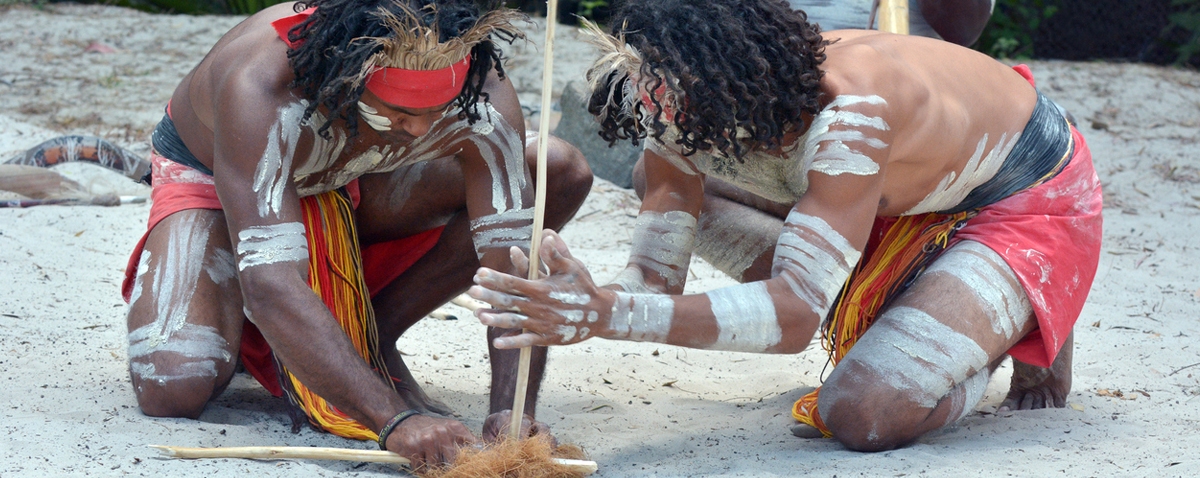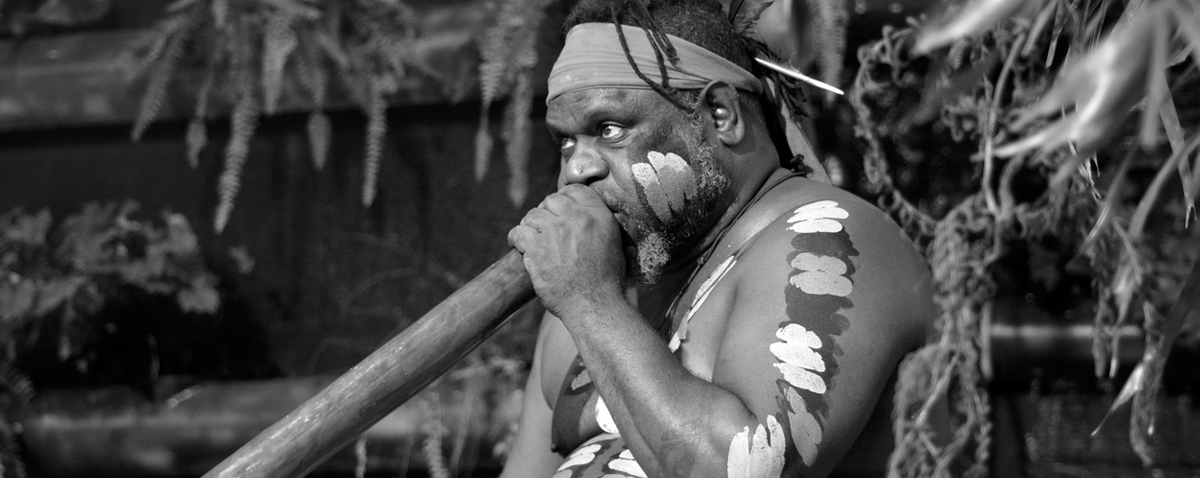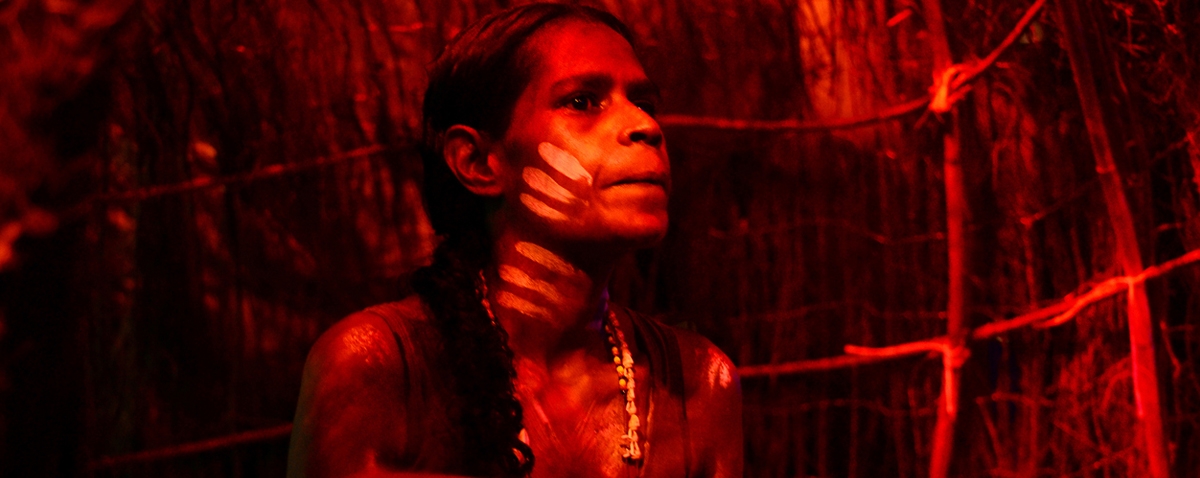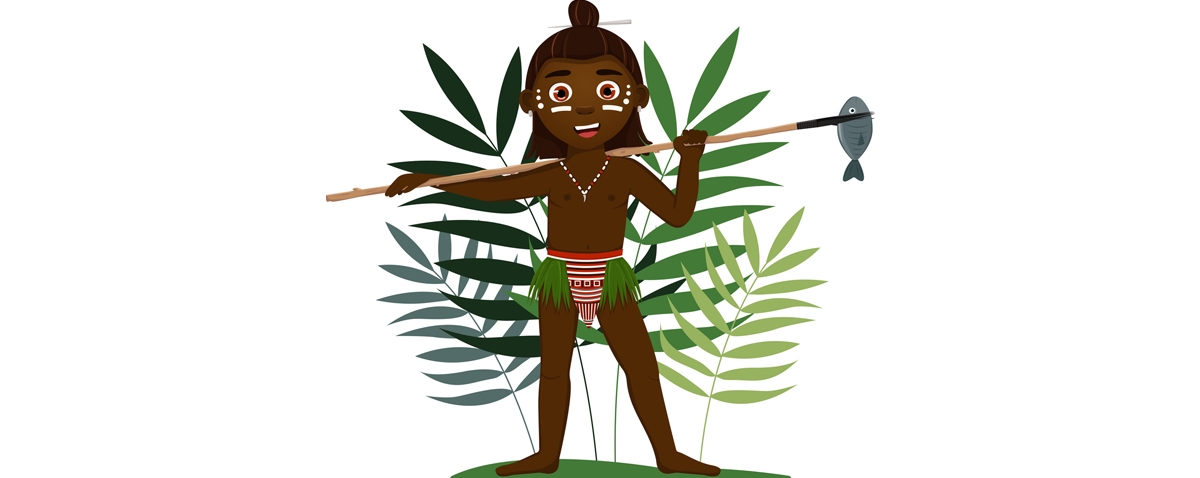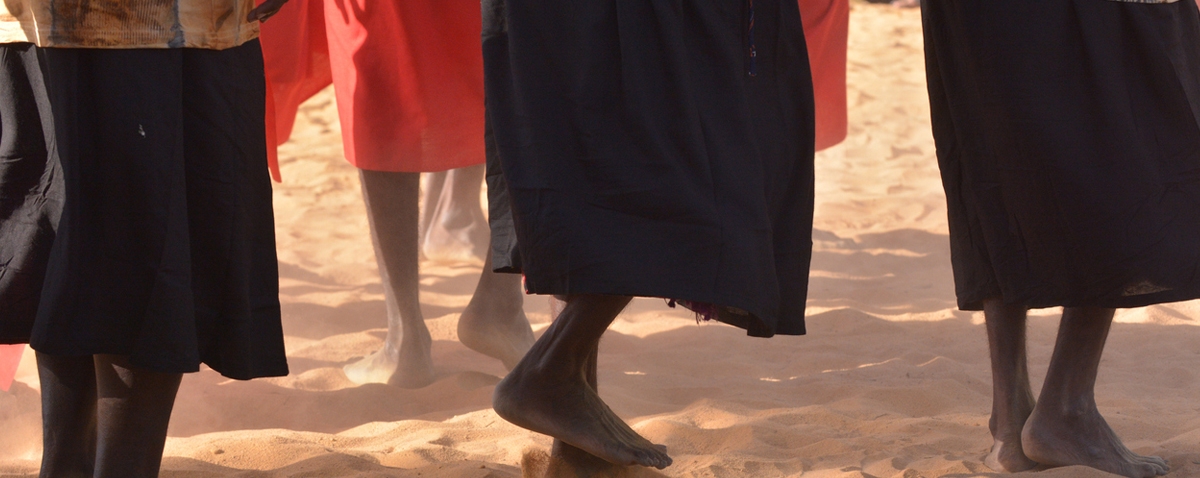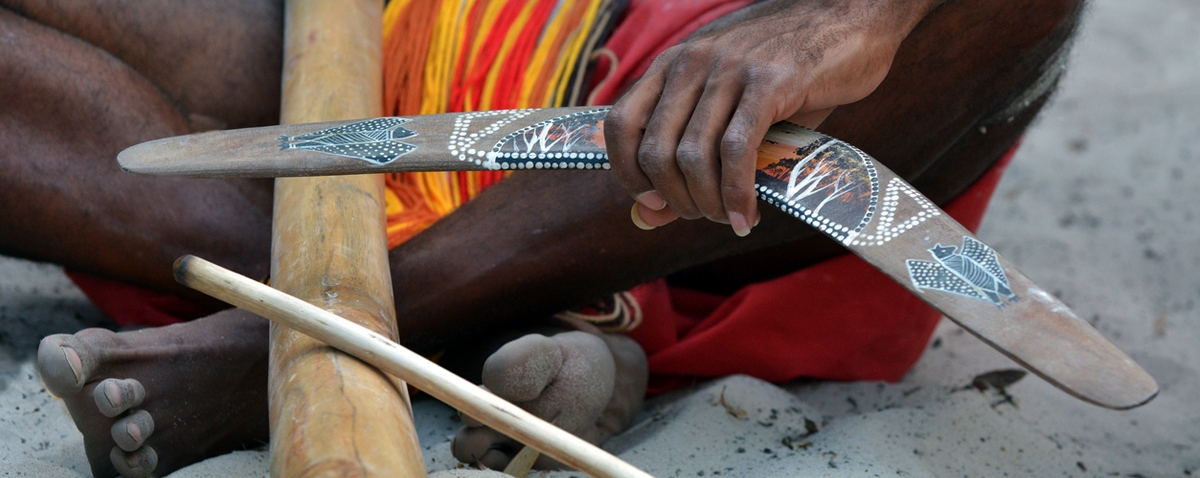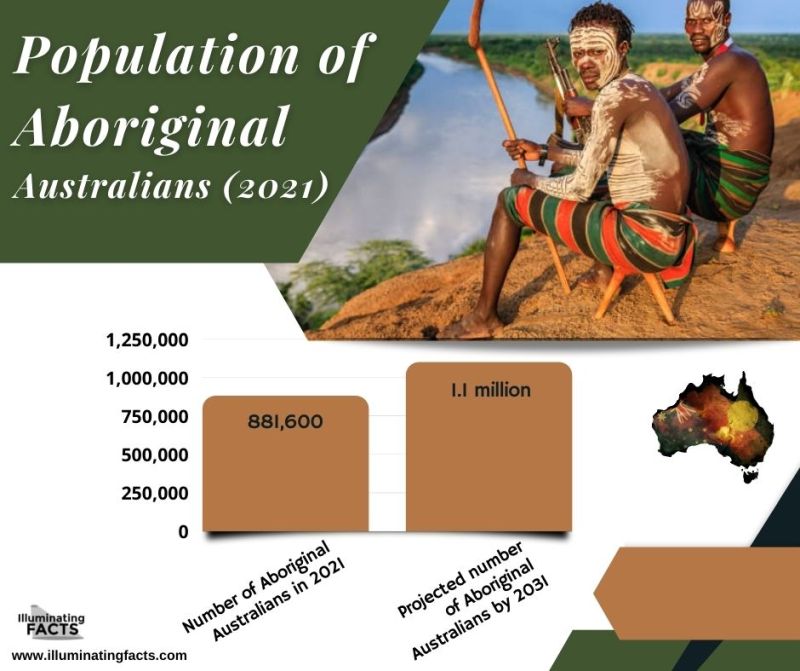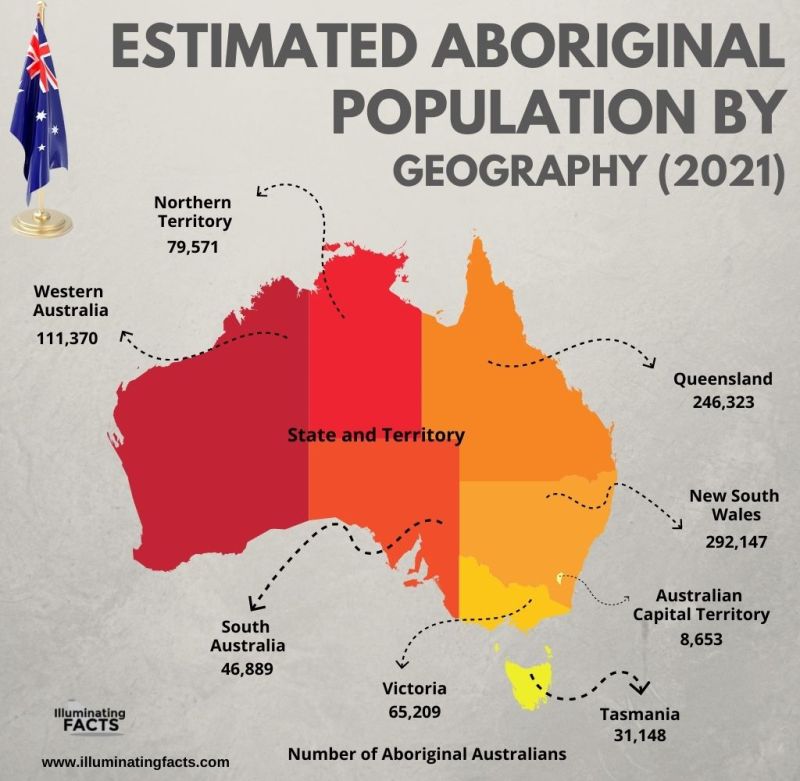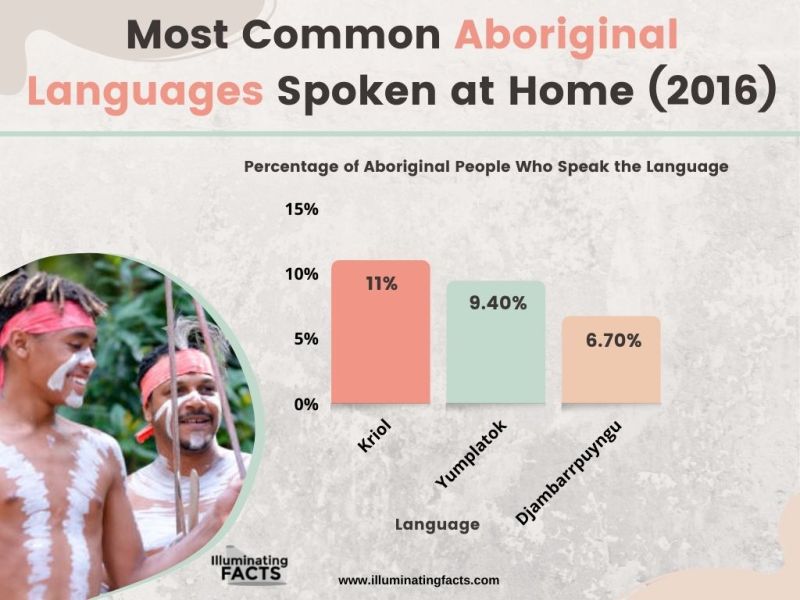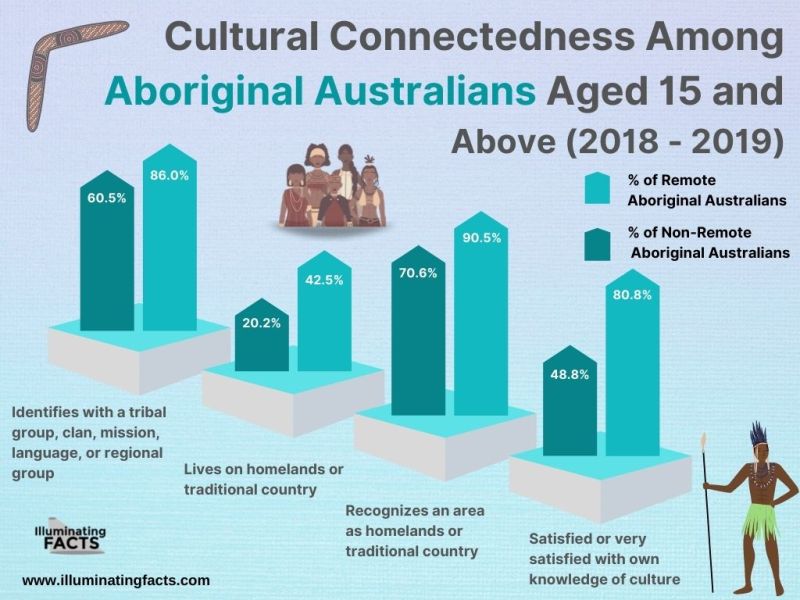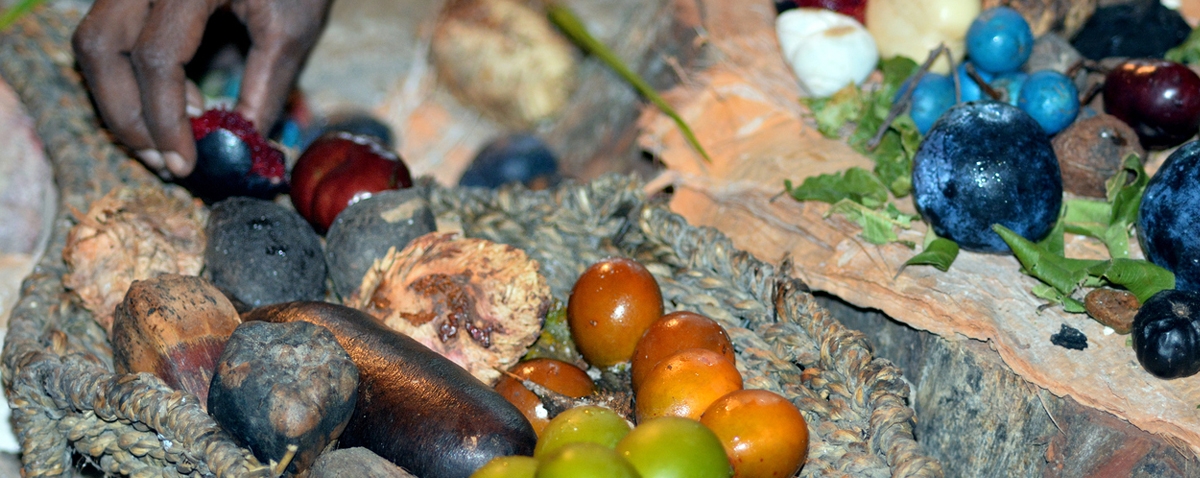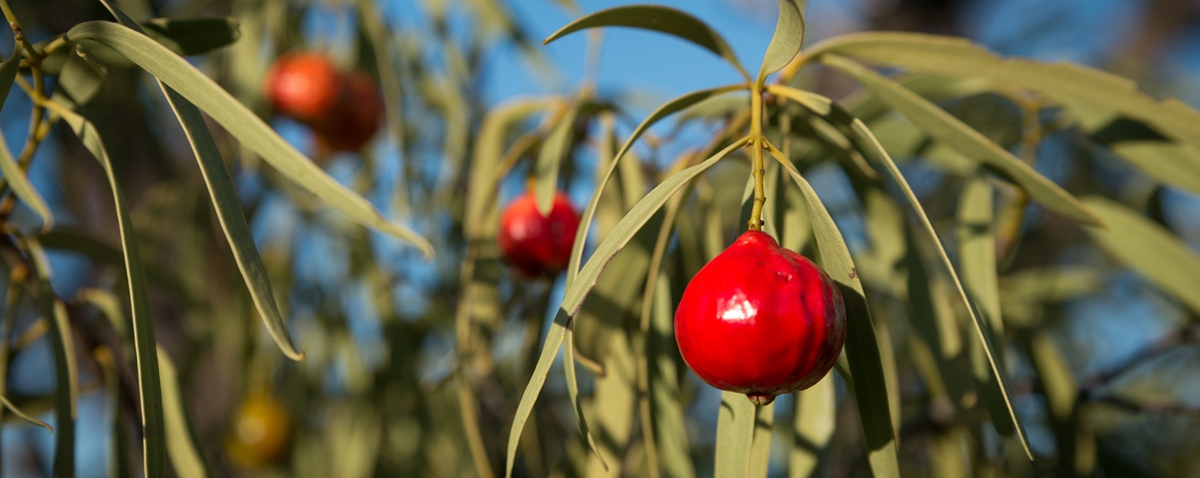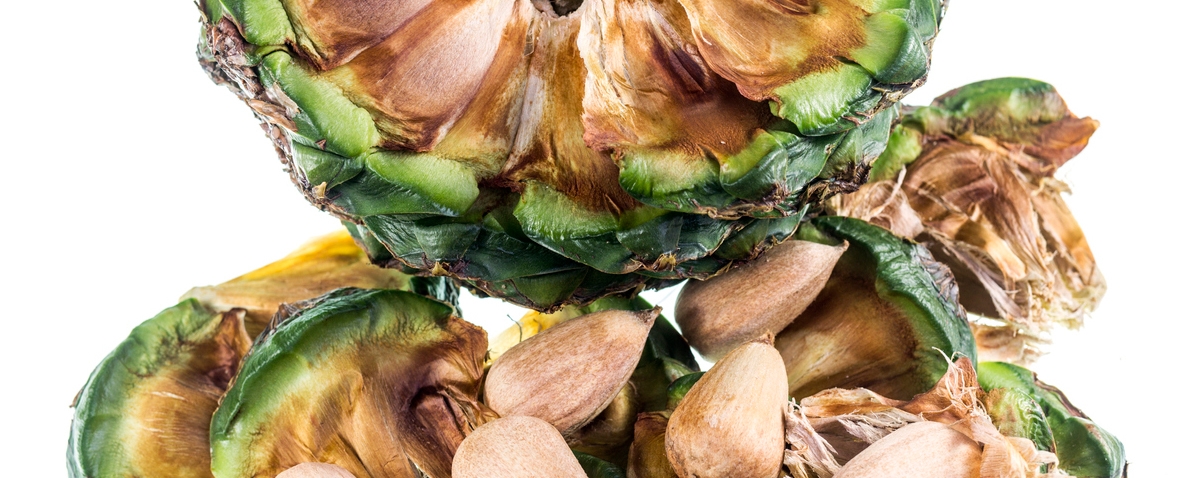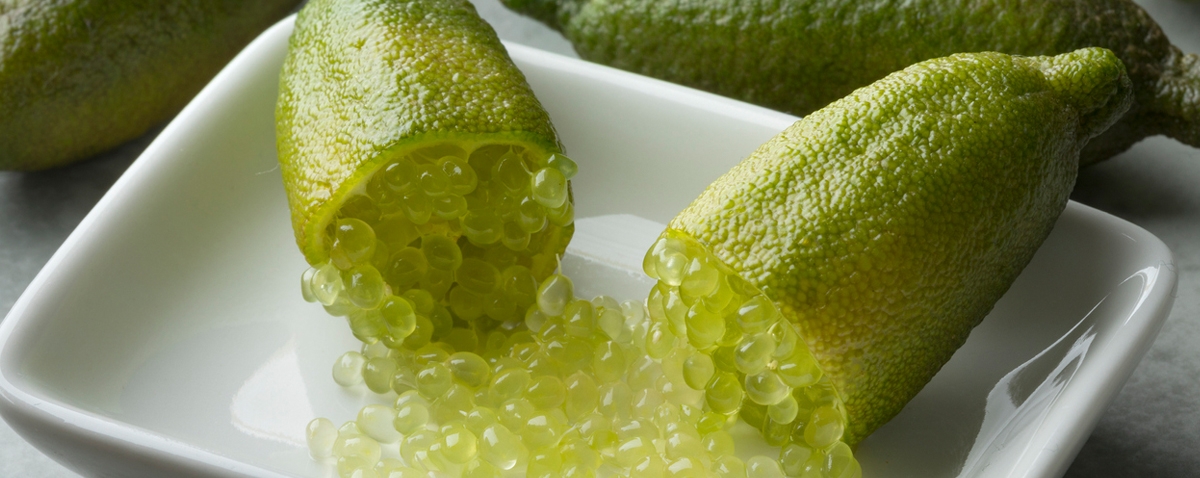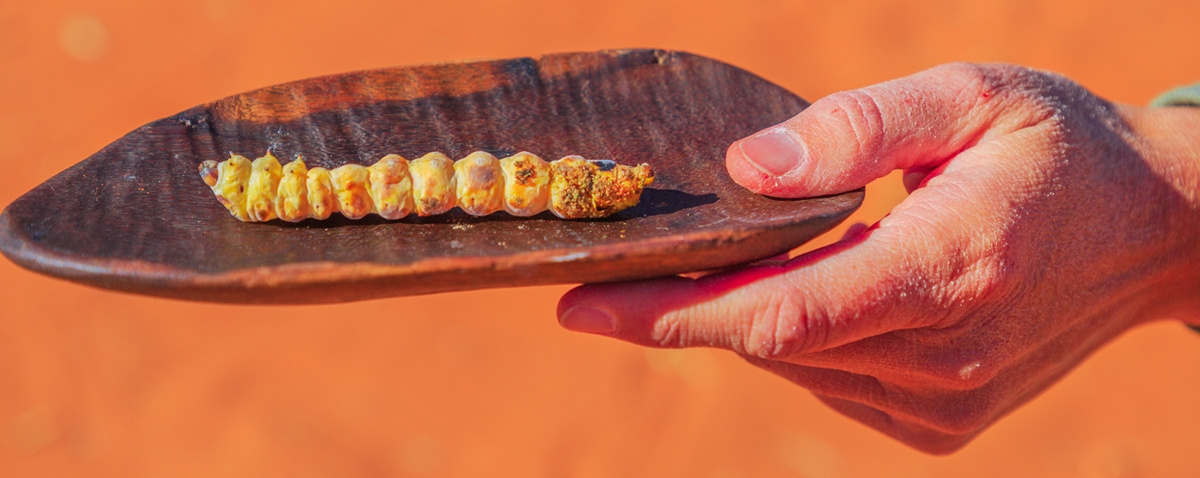Background
The first people in Australia are referred to as Aboriginal Australians. They have lived for more than 50,000 years. They can be divided into two groups. One is the Aboriginal peoples, who are related to those who already lived in Australia when Britain started colonizing the island in 1788. The other one is the Torres Strait Islander peoples, who came from inhabitants of the Torres Strait Islands, a mass of islands that is part of what we know today as Queensland, Australia.[1]
All Aboriginal Australians are linked to groups indigenous to Australia. However, using the term indigenous can be controversial since it can be used by people who descend from those who were not the island’s original inhabitants. Lawfully, “Aboriginal Australian” is a person of Aboriginal or Torres Strait Islander lineage who distinguishes as an Aboriginal or Torres Strait Islander and is welcomed by the community where he or she lives.[1]
Aboriginal man playing music on didgeridoo
an Aboriginal woman playing music using a clapstick
a vector illustration of an Aboriginal person
Aboriginal women in Australia performing a ceremony dance
Did you know that Aboriginal Australians could be the oldest population of humans living outside of Africa? Based on a theory, they migrated from boats around 70,000 years ago.[1] If you want to learn more about the aborigines, you’re in the right place. In this article, we are giving you information about Aboriginal Australians’ origins, culture, languages, and population. In addition, we are also giving you some of the most interesting facts about them that you need to learn.
Origins of Aboriginal Australians
Archeological remains and human skeletons in Australia can be traced back about 50,000 years before the trail disappeared. It means that before that, Australia was free of humans. With that, how do you think people get there, and when? Where did the people first arrive on the continent, and how did they spread across the country? Well, the answers to some of these questions can be found in the DNA of Aboriginal Australians.[2]
In 2017, genetic research on the genomes of 111 Aboriginal Australians was conducted. In that study, it was discovered that the Aboriginal Australians today are all related to a common ancestor who was part of a distinct population that appeared on the mainland about 50,000 years ago. Humans are believed to have migrated to Northern Australia from Asia via primitive boats. According to a theory, the early migrants themselves came out of Africa around 70,000 years ago, making Aboriginal Australians the oldest population of humans living outside Africa.[1]
The First Occupants of the Land
Before the Europeans arrived, Northern Sydney was populated by various Aboriginal clans. They lived mainly along the foreshores of the harbor, where they fished and hunted in the waters and backwoods of the area and harvested food from the surrounding bush. They were self-sufficient and harmonious and did not need to travel far from their lands since there were abundant resources. The trade with other tribal groups was also well established.
People only needed to spend around 4 to 5 hours a day working to ensure their survival, as they moved throughout the country following the seasons. Since they had lots of leisure time to spend, they could develop a rich and complex ritual life, including customs, language, spirituality, and the law.[3]
British Settlement
In 1770, the arrival of Lt. James Cook marked the start of the end of Aboriginal Australians’ ancient way of life. The voyage of exploration by Cook had sailed under commands to take ownership of the Southern Continent if it was unpopulated or with the consent of the natives if it was occupied. Either way, it was to be taken.
When they arrived, Lt. Cook announced the land he called New South Wales to be owned by King George III of Britain. He ignored the fact that the land was already well populated. He also failed to gain the consent of the natives, which started the legal fiction that Australia was wasted and unoccupied. He was then followed by the arrival of the First Fleet in January 1788, under the command of Captain Arthur Phillip, whose goal was to create a strict colony and take control of Terra Australia for settlement.[3] The first act of ownership done by the Europeans came four days after they arrived. An assembly of men from the HMS Sirius went onto the shore to clear land and access fresh water. After that, the First Fleet found its way to Sydney Cove and landed in the harbor.
In 1788, when British settlers started colonizing Australia, around 750,000 to 1.25 million Aboriginal Australians are estimated to have lived there. Later, epidemics began to spread among the island’s indigenous people, leading the British settlers to seize Aboriginal lands. Some Aboriginal Australians resisted, but up to 20,000 indigenous people died in violent conflict on the colony’s frontiers. Most of these were dominated by massacres and the impoverishment of their communities as British settlers seized their lands.[1]
Stolen Generations
From 1910 to 1970, government assimilation policies led to 10 and 33 percent of Aboriginal Australian children being removed from their homes by force. They were put in adoptive families and institutions and were not allowed to speak their native languages. Their names were also changed. It was only in 1967 when Australians voted that federal laws also would apply to Aboriginal Australians. Most of them did not have full citizenship or voting rights until 1965.
In 2008, Australian Prime Minister Kevin Rudd delivered a national apology for the country’s actions toward Aboriginal Australians of the Stolen Generations. After that, Australia has worked to lessen social disparities between Aboriginal Australians and non-indigenous Australians.[1]
Aboriginal Australians Today
At present, about 3% of the population of Australia has Aboriginal heritage. Today, Aboriginal Australians still find it challenging to retain their ancient culture and fight for recognition and restitution from the Australian government. Among the states in Australia, Victoria is currently working toward a first-of-its-kind treaty with the Aboriginal population that would recognize the sovereignty of Aboriginal Australians and includes compensation. However, Australia itself has never made such a treaty. It is the only country in the British Commonwealth not to have endorsed a treaty with its First Nations peoples.[1]
The Aboriginal Dreamtime
The worldview of Aboriginal peoples centered on “the Dreaming” or “Dreamtime,” which is a complex and comprehensive concept embodying the past, present, and future, as well as virtually every part of life.[4] The Dreamtime is commonly used to describe essential features of Aboriginal spiritual beliefs and existence. It is not mostly understood by non-indigenous people.[5]
For Aboriginals, the Dreamtime was way back, at the very beginning. They believed that the land and the people were made by the Spirits. They were the ones who created streams, rivers, hills, rocks, animals, and plants. They also trust that the Spirits provided their hunting tools and each tribe its land, totems, and Dreaming. The Aboriginals thought that the whole world was made by their Ancestors back in the very beginning of time, which is the Dreamtime.
The Ancestors created specific sites to show the Aboriginal people the places that were to be sacred. The Aboriginals executed ritual ceremonies and habitual songs near the sacred sites to please the Ancestral spirits and to keep themselves alive. Different tribes had various philosophies and beliefs regarding the Ancestors who made the world. Some believed that the Ancestors were animal spirits.[5]
Dreamtime is the basis of Aboriginal religion and culture, which dates back around 65,000 years. It is the tale of events that occurred, how the universe came to be, how humans were made, and how their Creator envisioned humans to function within the world as they knew it. Aboriginal people understood the Dreamtime as a start that never ended. They held the belief that it is a period of a continuum of past, present, and future.
The Aborigines learned about their initial stages through their Dreamtime creation folktales that told of the significant actions of the creators. The myths became the foundation of Aboriginal society and gave certainty about existence. They believed that creators made men, women, and animals during the Dreamtime. That they professed the laws of the land and how people were to act toward one another, the customs of food supply and apportionment, the rites of initiation, and the rituals of death which are needed to be done so the spirit of the dead could travel peacefully to his or her spirit-place, and the commandments of marriage.
Some Dreamings were about the mythical creators disappearing. They believed that the creators vanished from the sight of mere mortals but continuously lived in secret places. Some lived in rock crevices, water holes, and trees. Others went up into the sky as heavenly bodies, while others changed into or became natural forces, such as rain, lightning, thunder, and wind.
The Aboriginal Dreamtime is difficult for many of us to fully understand. But it is something that is part of who the Aboriginal people are, the core and reason for being here. It is all encircling and will forever be at the center of their being as a people.[5]
Population, Size, and Location
In this part, we will show you Aboriginal Australians’ population, size, and location.
The Population of Aboriginal Australians
The population of Aboriginal and Torres Strait Islanders (2016) |
|
| Aboriginal Origin: | 91% or 727,500 people |
| Torres Strait Islander Origin: | 4.8% or 38,700 people |
| Both Aboriginal and Torress Strait Islander Origin: | 4.0% or 32,200 people |
| Estimated Total Number of Aboriginal and Torres Strait Islander people in Australia in 2016: | 3.3% of the total Australian population, or 798,400 people |
There was an estimated 798,400 Aboriginal and Torres Strait Islander people in Australia in 2016. This represents 3.3% of the total Australian population. In that year, 91% of the Indigenous Australian population were of Aboriginal origin, around 727,500 people. Around 4.8% were of Torres Strait Islander origin, estimated at around 38,700 people. About 4% were of Aboriginal and Torres Strait Islander origin, an estimated 32,200 people.[6]
According to the Australian Bureau of Statistics or ABS projections, the number of Aboriginal Australians in 2021 was approximately 881,600. By 2031, it is projected to reach about 1.1 million people.[6]
Geographic Distribution
Aboriginal Australians live in all parts of the country, from cities to remote tropical and desert areas. They are more likely to live in urban and regional areas compared to distant areas, though the percentage of the total population who are Aboriginal is normally higher in more remote areas.
According to 2021 projections, among Aboriginal Australians, 38% or 337,400 live in major cities, 44% or 389,200 live in inner and outer regional areas, and 18% or 154,900 live in remote and very remote areas combined.
In 2021, an estimated 33% or 292,100 Aboriginal Australians lived in New South Wales and 28% or 246,300 people in Queensland. The Northern Territory has the highest number of Aboriginal residents among its population, an estimated 31% or 79,600 people in 2021.[6]
Language and Culture
Aboriginal communities pass on knowledge, tradition, ceremony, and culture from one generation to the next through language, storytelling, elders’ teachings, performance, and protection of significant sites. Cultural factors, including connection to community, land, and spirituality, are essential for Aboriginal Australians’ social and emotional well-being.
Language
In the Census of Population and Housing that was done in 2016, one in every ten or 9.8% of Aboriginal Australians reported that they spoke an Aboriginal language at home, with more than 150 Aboriginal languages being spoken. Some of the most common languages spoken at home were Kriol, Yumplatok, and Djambarrpuyngu.[6]
Cultural Connectedness
Based on the 2018-2019 National Aboriginal and Torres Strait Islander Health Survey, Aboriginal Australians have strong connections to their family, culture, and community.
Among Aboriginal Australians aged 15 and above, 74% recognized an area as a homeland or traditional country, while 66% identified with a tribal group, language, mission, clan, or regional group. Also, 24% of them live in their homeland.[6]
Aboriginal Cuisine
Australia’s diversity means a wide selection of Aboriginal foods and bush foods or “bush tucker.” By closely observing nature and learning when certain flowers bloom, fruits ripen, and fish and animals fatten, Aboriginal Australians have learned to survive for thousands of years. This wisdom has been handed down over generations, making bush tucker sampling today not just a culinary experience but also a cultural journey through time.[7]
Aboriginal Australians have consumed native plant and animal foods for around 60,000 years. The traditional methods used to process these foods developed over time, with the toxicity of these ingredients playing an essential role in how bush tucker was prepared and eaten. Hunter-gatherers would look for energy-dense foods that could provide them with the needed sugar, protein, and fat for survival in the harsh conditions of the bush. Most of the time, these include animal meat and offal, grubs and insects, fruits, and honey. They eat raw plant foods while meats are cooked over hot campfire coals, wrapped in paperbark, and baked in ground ovens. The bush tucker diet gave high nutrition, offering good levels of protein, fiber, and micronutrients.[8]
Native Australian Bush Tucker Foods
Here are some examples of the native bush tucker foods which are popular among Aboriginal Australians:
Desert Quandong
This is usually found in arid and semi-arid regions of South Australia and the central deserts. It is also called sweet quandong and desert peach. This was an important food source for Aboriginal Australians for thousands of years. It was also used by early Europeans in making pies, jams, and jellies. It can be eaten fresh or dried, with dried fruit prized for its ability to be kept for long periods. It can be kept for up to 8 years. Its taste is similar to beans or dry lentils with earthy notes.[8]
Bunya Nut
Bunya pine trees can be found naturally in South East Queensland and in Queensland’s World Heritage-listed Wet Tropics to the north. The bunya cone can weigh up to 18 kilograms and contain up to a hundred large kernels or nuts. Their cones were a very essential food source for Aboriginal tribes who lived in Queensland. Their families would own a group of bunya trees and pass them down from one generation to the next. Large harvest festivals were also held during the cone-fall season every two to seven years. Bunya nuts were traditionally grounded into a paste and eaten directly or cooked to make bread.[8]
Desert Lime
This one is native to New South Wales, Queensland, and South Australia. It is among the several citrus species that can be found in Australia. It can grow as big as grapes. It has an intense and zesty flavor and is usually eaten whole by those who live off the land. For many generations, desert limes were used to make sauces, pickles, marmalades, and garnishes. Currently, it is a highly-prized ingredient used in flavored powders and anti-aging spa and facial treatments.[8]
Finger Lime
This lime is also referred to as caviar lime. It is long in shape and filled with caviar-like pearls that pop with an irresistible flavor similar to regular limes. They were essential for Aboriginal Australians for thousands of years as they are rich in vitamin E, vitamin C, potassium, and folate. In addition, it has also been used as a topical treatment for infected sores. Today, it is being used in many restaurants in Australia.[8]
Ruby Saltbush
This bush can be spotted in every state in Australia. It is a semi-succulent native shrub with cylindrical leaves, small berries, and hairy stems. The berries are edible and have a crisp and salty-sweet flavor. You can pick them right off the plant and eat them raw, making them a great snack food. For generations, they were a quick and convenient snack food for desert-dwelling Aboriginal Australians. These berries are still often collected today.[8]
Lemon Myrtle
Lemon myrtle is known in the culinary world for its clean, fresh, and defined lemon fragrance and flavor. But its use dates back 40,000 years as it was incorporated into cuisine and medicine by Aboriginal Australians. They used the leaves to flavor dishes and as well as to alleviate headaches by inhaling the scent.[8]
Tasmanian Pepperberry
It was well-documented that the Aboriginal Australians used this pepper as a flavoring agent in food and as traditional medicine. They would crush it to create a paste and apply it to sore gums, toothaches, and other skin disorders. It is currently used as a flavoring for different foods, including curries, cheese, and even alcoholic drinks.[8]
Moreton Bay Chestnut
This is also called the “blackbean.” It is an evergreen tree that grows up to 40 meters tall. It has chestnut-like seeds that were used as native Australian bush tucker for around 2,500 years. However, unprocessed seeds can’t be eaten as they are toxic to humans. They need to be prepared carefully to become edible. The Aboriginal people invented a way to leach the toxins out of them. They would cook the seeds in a fire, cut them up into pieces, and soak them in water for a few days. Then, they would pound the seeds into flour, which is used to make unleavened bread. At present, it is not a widely used ingredient. [8]
Bush Coconut
This one is a combination of both a plant and an animal. That may sound strange, but it is true. It grows only on desert bloodwood eucalyptus trees. They are formed through a symbiotic relationship between the tree and an adult female scale insect. When the insect attaches to the tree, the tree triggers a defense mechanism, growing a “gall” around it. It would look like a small, woody fruit that can grow as big as tennis balls. These were harvested by the Aranda people of Central Australia and eaten for their nutritious flesh.[8]
Witchetty Grub
These are large, worm-like creepy crawlies that are white wood-eating moth larvae. These love to feed on the roots of the witchetty bush and the wood of black wattle trees, making them easy to spot. They were often eaten raw or roasted in hot ashes. It may sound weird, but their liquid center tastes nutty and almond-like when eaten raw. The inside part turns a bit yellow when they are cooked, and the outer skin becomes like crisp roast chicken. Others say it tastes like scrambled eggs, while others say it reminds them of popcorn.[8]
Interesting Facts About Aboriginal Australians
If you want to learn more about Aboriginal Australians, here are some of the most interesting facts that you need to know about them and their culture:
- There is no singular Aboriginal culture. Aboriginal Australians belong to different social groups, which are made of various nations. Each of them maintains its language, culture, and beliefs. There can be some overlap and many similarities, but there are also essential differences between them: each inhabits its unique “country.”
- There are hundreds of languages among Aboriginal Australians. When their territory was brutally colonized by the British in the 18th century, there were about 250 various Aboriginal languages that were spoken around Australia. Among those, more than 100 are still in use today. These different languages are as distinct as all the different corners of the continent.
- Aboriginal culture is the oldest living civilization on Earth. Based on archeological evidence, Aboriginal Australians have been inhabiting the continent for at least 60,000 years, making their culture the oldest surviving civilization on the face of the Earth.
- Aboriginal culture is still lively today. Even though this culture is ancient, it is not extinct. The stories, art, and rituals keep their traditions well and alive in the 21st century. Their population is also growing. There are around 700,000 Aboriginal Australians today, projected to grow to more than 1 million people over the next two decades.
- Even though the image of Aboriginal Australians is often depicted in the outback, their culture does not simply exist in the bush. Almost 35% live in major cities, 44% in regional towns, and 21% in remote areas. This means that they are very present in urban life.
- The traditions of Aboriginal Australians are passed down through stories. Their concept of Dreaming continues to exist today in the places and creatures around us. This cultural knowledge is passed on through generations through rituals, songs, and stories.
- One common thread that runs through Aboriginal culture is respect for the land. It is believed that ancestor beings traveled across the country to form landmarks and places of interest out of the previously shapeless landscape. They formed songlines or trails that connected the sacred sites made by these spirit beings. The Aboriginal Australians show respect for their ancestors through respect for the country.
- One of the major ancestor spirits for Aboriginal Australians is the Rainbow Serpent. It is the pre-eminent creator god in their mythology. However, its Dreaming story is not like the European “Adam and Eve” tale. This ancestor provided water and life to the land and is therefore viewed as the creator of the universe in some communities.
- Music plays a very important role in Aboriginal culture. Some examples of Aboriginal instruments are the didgeridoo and clapping sticks, and they play a big role in traditional culture. There is also no shortage of contemporary Aboriginal singers and bands.
- Art is also very essential for Aboriginal Australians. Aboriginal rock painting is the longest unbroken art tradition on the planet, with creations in the Narwala Gabarnmang rock shelter in Arnhem Land in the Northern Territory, which dates to 28,000 years. Today, Aboriginal art continues to thrive. You can find many prominent galleries in Perth, Melbourne, Sydney, and Central Australia.[9]
Conclusion
It is truly amazing to learn how a certain culture that existed more than 50,000 years ago is still alive and vibrant today. Aboriginal history has been handed down in many ways through legends, myths, stories, and dances. Their Dreaming is history. A history of how the world was transformed into waterways, valleys, hills, and mountains. It tells them about how the stars were made and how the sun came to be.
We must remember that all Aboriginal sites are important to them, as they are evidence of their past and are valued as a connection with their traditional culture. If you are into learning more about their culture, there are many tours you can try in Australia that will tell you more about Aboriginal Australians’ rich culture and history. We hope this article helped you learn more about the Aborigines.
References
[1] Blakemore, E. (2021, May 4). Aboriginal Australians, facts and information. Culture. Retrieved February 17, 2022, from https://www.nationalgeographic.com/culture/article/aboriginal-australians#:~:text=Aboriginal%20origins&text=Humans%20are%20thought%20to%20have,of%20humans%20living%20outside%20Africa.
[2] Zimmer, C. (2017, March 8). How did Aboriginal Australians arrive on the continent? DNA helps solve a mystery. The New York Times. Retrieved February 17, 2022, from https://www.nytimes.com/2017/03/08/science/aboriginal-australians-dna-origins-australia.html
[3] aboriginalheritage.org, E. (2010). A Brief Aboriginal History. A brief aboriginal history. Retrieved February 17, 2022, from https://www.aboriginalheritage.org/history/history/
[4] Tonkinson, R., & Berndt, R. M. (2018, April 19). Traditional socio-cultural patterns. Encyclopædia Britannica. Retrieved February 18, 2022, from https://www.britannica.com/topic/Australian-Aboriginal/Traditional-sociocultural-patterns
[5] Linklater, S. (2021, October 13). What is aboriginal dreamtime? Artlandish Aboriginal Art. Retrieved February 18, 2022, from https://www.aboriginal-art-australia.com/aboriginal-art-library/aboriginal-dreamtime/
[6] Australian Institute of Health and Welfare, E. (2021, September 16). Profile of Indigenous Australians. Australian Institute of Health and Welfare. Retrieved February 18, 2022, from https://www.aihw.gov.au/reports/australias-welfare/profile-of-indigenous-australians
[7] Australia.com, E. (2020). Australian Aboriginal Cultures – Tourism Australia. Australian Aboriginal cultures – Tourism Australia. Retrieved February 18, 2022, from https://www.australia.com/en/things-to-do/aboriginal-australia/culture.html
[8] Goh, A. (2021, March 4). Guide to Australian Bush Tucker – 10 unique Aboriginal Foods to discover (from pepperberries to Bunya Nuts!). TourHero. Retrieved February 18, 2022, from https://www.tourhero.com/en/magazine/gastronomy/guide-to-australian-bush-tucker-10-ingredients-used-in-traditional-aboriginal-food/
[9] Smith, T. (2018, February 18). 11 things you should know about indigenous Australian culture. Culture Trip. Retrieved February 18, 2022, from https://theculturetrip.com/pacific/australia/articles/11-things-you-should-know-about-indigenous-australian-culture/

